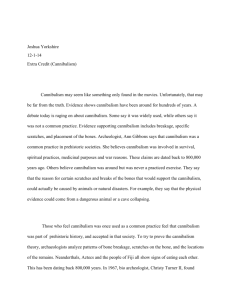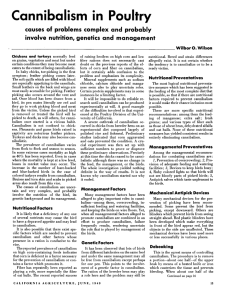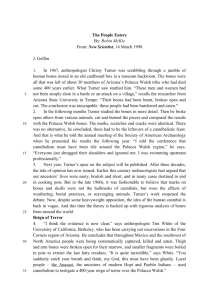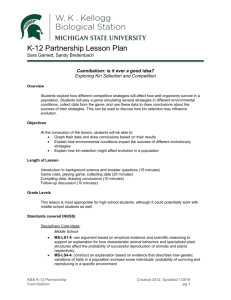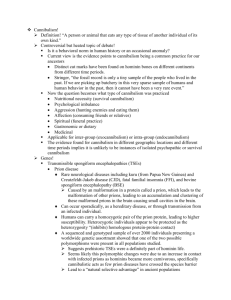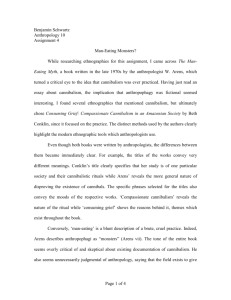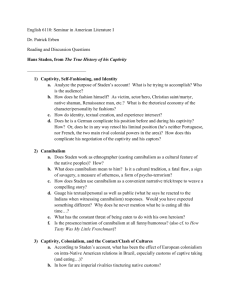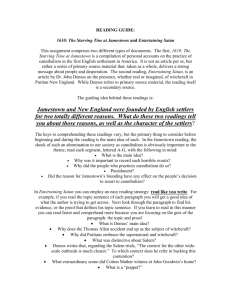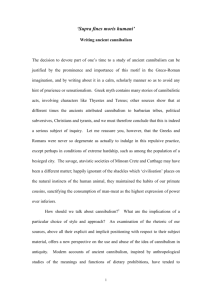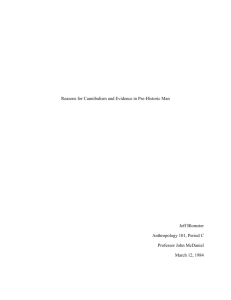Cannibalism: It Still Exists
advertisement
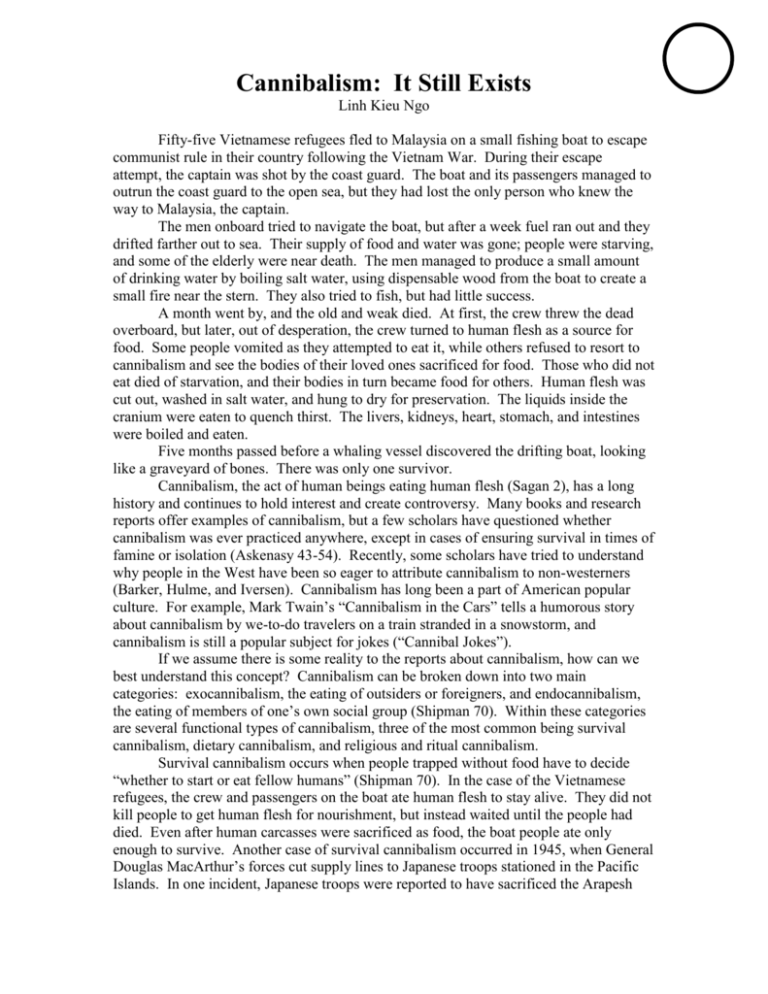
Cannibalism: It Still Exists Linh Kieu Ngo Fifty-five Vietnamese refugees fled to Malaysia on a small fishing boat to escape communist rule in their country following the Vietnam War. During their escape attempt, the captain was shot by the coast guard. The boat and its passengers managed to outrun the coast guard to the open sea, but they had lost the only person who knew the way to Malaysia, the captain. The men onboard tried to navigate the boat, but after a week fuel ran out and they drifted farther out to sea. Their supply of food and water was gone; people were starving, and some of the elderly were near death. The men managed to produce a small amount of drinking water by boiling salt water, using dispensable wood from the boat to create a small fire near the stern. They also tried to fish, but had little success. A month went by, and the old and weak died. At first, the crew threw the dead overboard, but later, out of desperation, the crew turned to human flesh as a source for food. Some people vomited as they attempted to eat it, while others refused to resort to cannibalism and see the bodies of their loved ones sacrificed for food. Those who did not eat died of starvation, and their bodies in turn became food for others. Human flesh was cut out, washed in salt water, and hung to dry for preservation. The liquids inside the cranium were eaten to quench thirst. The livers, kidneys, heart, stomach, and intestines were boiled and eaten. Five months passed before a whaling vessel discovered the drifting boat, looking like a graveyard of bones. There was only one survivor. Cannibalism, the act of human beings eating human flesh (Sagan 2), has a long history and continues to hold interest and create controversy. Many books and research reports offer examples of cannibalism, but a few scholars have questioned whether cannibalism was ever practiced anywhere, except in cases of ensuring survival in times of famine or isolation (Askenasy 43-54). Recently, some scholars have tried to understand why people in the West have been so eager to attribute cannibalism to non-westerners (Barker, Hulme, and Iversen). Cannibalism has long been a part of American popular culture. For example, Mark Twain’s “Cannibalism in the Cars” tells a humorous story about cannibalism by we-to-do travelers on a train stranded in a snowstorm, and cannibalism is still a popular subject for jokes (“Cannibal Jokes”). If we assume there is some reality to the reports about cannibalism, how can we best understand this concept? Cannibalism can be broken down into two main categories: exocannibalism, the eating of outsiders or foreigners, and endocannibalism, the eating of members of one’s own social group (Shipman 70). Within these categories are several functional types of cannibalism, three of the most common being survival cannibalism, dietary cannibalism, and religious and ritual cannibalism. Survival cannibalism occurs when people trapped without food have to decide “whether to start or eat fellow humans” (Shipman 70). In the case of the Vietnamese refugees, the crew and passengers on the boat ate human flesh to stay alive. They did not kill people to get human flesh for nourishment, but instead waited until the people had died. Even after human carcasses were sacrificed as food, the boat people ate only enough to survive. Another case of survival cannibalism occurred in 1945, when General Douglas MacArthur’s forces cut supply lines to Japanese troops stationed in the Pacific Islands. In one incident, Japanese troops were reported to have sacrificed the Arapesh people of northeastern New Guinea for food in order to avoid death by starvation (Tuzin 63). The most famous example of survival cannibalism in American history comes from the diaries, letters, and interviews of survivors of the California-bound Donner Party, who in the winter of 1846 were snowbound in the Sierra Nevada Mountains for five months. Thirty-five of the eighty-seven adults and children died, and some of them were eaten (Hart 116-17; Johnson). Unlike survival cannibalism, in which human flesh is eaten as a last resort after a person has died, in dietary cannibalism, humans are purchased or trapped for food and then eaten as a part of a culture’s traditions. In addition, survival cannibalism often involves people eating other people of the same origins, whereas dietary cannibalism usually involves people eating foreigners. In Miyanmin society of the west Sepik interior of Papua, New Guinea, villagers do not value human flesh over that of pigs or marsupials because human flesh is part of their diet (Poole 17). The Miyanmin people observe no differences in “gender, kinship, ritual status, and bodily substance”; they eat anyone, even their own dead. In this respect, then, they practice both endocannibalism and exocannibalism; and to ensure a constant supply of human flesh for food, they raid neighboring tribes and drag their victims back to their village to be eaten (Poole 11). Perhaps, in the history of this society, there was at one time a shortage of wild game to be hunted for food, and because people were more plentiful than fish, deer, rabbits, pigs, or cows, survival cannibalism was adopted as a last resort. Then, as their culture developed, the Miyanmin may have retained the practice of dietary cannibalism, which has endured as a part of their culture. Similar to the Miyanmin, the people of the Leopard and Alligator societies in South America eat human flesh as part of their cultural tradition. Practicing dietary exocannibalism, the Leopard people hunt in groups, with one member waring the skin of a leopard to conceal the face. They ambush their victims in the forest and carry their victims back to their village to be eaten. The Alligator people also hunt in groups, but they hide themselves under a canoelike submarine that resembles an alligator, then swim close to a fisherman’s or trader’s canoe to overturn it and catch their victims (MacCormack 54). Religious or ritual cannibalism is different from survival and dietary cannibalism in that it has a ceremonial prupose rather than one of nourishment. Sometimes only a single victim is sacrificed in a ritual, while at other times many are sacrificed. For example, the Bangala tribe of the Congo River in central Africa honors a deceased chief or leader by purchasing, sacrificing, and feasting on slaves (Sagan 53). The number of slaves sacrificed is determined by how highly the tribe members revered the deceased leader. Ritual cannibalism among South American Indians often serves as revenge for the dead. Like the Bangalas, some South American tribes kill their victims to be served as part of funeral rituals, with human sacrifices denoting that the deceased was held in high honor. Also like the Bangalas, these tribes use outsiders as victims. Unlike the Bangalas, however, the Indians sacrifice only one victim instead of many in a single ritual. For example, when a warrior of a tribe is killed in battle, the family of the warrior forces a victim to take the identity of the warrior. The family adorns the the victim with the deceased warrior’s belongings and may even force him to marry the deceased warrior’s wives. But once the family believes the victim has assumed the spiritual identity of the deceased warrior, the family kills him. The children in the tribe soak their hands in the victim’s blood to symbolize their revenge on the warrior’s death. Elderly women from the tribe drink the victim’s blood and then cut up his body for roasting and eating (Sagan 53-54). By sacrificing a victim, the people of the tribe believe that the death of the warrior has been avenged and the soul of the deceased can rest in peace. In the villages of certain African tribes, only a small part of a dead body is used in ritual cannibalism. In these tribes, where the childbearing capacity of women is highly valued, women are obligated to eat small, raw fragments of genital parts during fertility rites. Elders of the tribe supervise this ritual to ensure that the women will be fertile. In the Bimin-Kuskusmin tribe, for instance, a widow eats a small, raw fragment of flesh from the penis of her deceased husband in order to enhance her future fertility and reproductive capacity. Similarly, a widower may eat a raw fragment of flesh from his deceased wife’s vagina along with a piece of her bone marrow; by eating her flesh, he hopes to strengthen the fertility capacity of his daughters borne by his dead wife, and by eating her bone marrow, he honors her reproductive capacity. Also, when an elder woman of the village who has shown great reproductive capacity dies, her uterus and the interior parts of her vagina are eaten by other women who hope to further benefit from her reproductive power (Poole 16-17). Members of developed societies in general practice none of these forms of cannibalism, with the occasional exception of survival cannibalism when the only alternative is starvation. It is possible, however, that our distant-past ancestors were cannibals who through the eons turned away from the practice. We are, after all, descended from the same ancestors as the Miyanmin, the Alligator, and the Leopard people, and survival cannibalism shows that people are capable of eating human flesh when they have no other choice. Works Cited Askenasy, Hans. Cannibalism: From Sacrifice to Survival. Amherst, NY: Prometheus, 1994. Barker, Francis, Peter Hulme, and Margaret Iversen, eds. Cannibalism and the New World. Cambridge: Cambridge UP, 1998. Brown, Paula, and Donald Tuzin, eds. The Ethnography of Cannibalism. Washington: Society of Psychological Anthropology, 1983. “Cannibal Jokes.” The Loonie Bin of Jokes. 22 Sept. 1999 <http://www.looniebin.mb. ca/cannibal.html>. Hart, James D. A Companion to California. Berkeley: U of California P, 1987. Johnson, Kristin. “New Light on the Donner Party.” 28 Sept 1999 <http://www.metrogourmet.com/crossroads.KJhome.htm>. MacCormack, Carol. “Human Leopard and Crocodile.” Brown and Tuzin 54-55. Poole, Fitz John Porter. “Cannibals, Tricksters, and Witches.” Brown and Tuzin, 11, 1617. Segan, Eli. Cannibalism. New York: Harper, 1976. Shipman, Pat. “The Myths and Perturbing Realities of Cannibalism.” Discover Mar. 1987: 70+. Tuzin, Donald. “Cannibalism and Arapesh Cosmology.” Brown and Tuzin 61-63. Twain, Mark. “Cannibalism in the Cars.” The Complete Short Stories of Mark Twain. Ed. Charles Neider. New York: Doubleday, 1957. 9-16.
